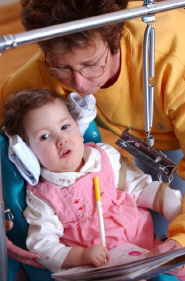|
Girl, 2, Defying Disease &
Doctors

Janet Merkle with her granddaughter, Emma Lockwood.
By
Lia Luz
Post staff reporter
Beth and Kevin Lockwood of Withamsville never heard of Spinal Muscular
Atrophy before they learned it might kill their first child, Emma.
Now, they
find themselves facing the same terrifying prospect with a second
child.
Doctors told
them the disease destroys the motor neurons controlling body movements
such as crawling, walking, swallowing and breathing.
They also
told them there is no cure.
"We were
shocked," Beth Lockwood said. "We decided to do everything
we could to keep her living."
Spinal
Muscular Atrophy is largely unknown and federal funding for research
to find a cure for it is limited.
Researchers,
nonetheless, believe they are close to finding a cure.
Biomedical
researchers at Ohio State University already have identified the gene
that causes the disease, and researchers have been able to cure mice
afflicted with it.
"They
are fairly close to finding a cure in humans. With the necessary
funds, they might find it in three years," Lockwood said.
When her
daughter was 8 months old, a blood test confirmed that Emma had Type 1
SMA, the worst form of the disease, where patients are at risk
of pulmonary failure.
Doctors said
Emma likely wouldn't live to see her second birthday.
The Lockwoods,
however, believe Emma's chance of survival is much better today than
when she was originally diagnosed. Their daughter turned 2 in December
and has been very stable.
"We keep
the faith," Lockwood said.
"The
Lockwoods have taught me that nothing is impossible," said Brenda
Wong, Emma's neurologist at Cincinnati Children's Hospital Medical
Center.
"They
taught me that the amount of care and dedication makes all the
difference."
Emma was the
only child currently known to have Type 1 SMA in Greater Cincinnati
until her brother, Nicholas, also was diagnosed with the same type of
the disease when he was 5 months old.
The Lockwoods
noticed he was suffering movement limitations at the age of 3 months.
"We were
very upset, but we knew the risks," Lockwood said.
"It
wasn't as bad as when we learned about Emma's diagnosis."
SMA is a
recessive genetic disease, which means that both parents must be
carriers of the gene responsible for it.
Annette Reed
of Dublin, whose daughter, Madison, also is affected with Type 1 SMA,
believes a cure is on the horizon.
"They
have done amazing progress in the last seven years," she said.
"They're very hopeful in finding a cure."
Annette and
her husband, Carl, created a foundation called Miracle for Madison
Fund to raise needed dollars for researchers and an SMA clinic at OSU.
The
foundation supports Families of Spinal Muscular Atrophy, an
international organization pushing the medical establishment to find a
cure for SMA. The organization also provides medical equipment and
services for its 13,000 members.
Doctors gave
the Reeds the same bad news they gave the Lockwoods. They told them
that Madison probably would not live past the age of 2.
But she is
now 6.
"The
reason why Madison is still living is because of all the things we do
to help with the symptoms," her mother said.
Madison
receives a variety of therapies and relies on specialized medical
equipment to help her breath, swallow, cough and eliminate secretions.
Doctors and
speech therapists had told the Reeds that it would be a waste of time
to try to teach Madison how to speak. However Madison, who has a home
school teacher, can now talk.
"Children
with SMA are usually very bright," said Wong.
"Madison
is a very happy child. She smiles from the time she wakes up to the
time she goes to bed," her mother said.
There is no
reason for children afflicted with the disease to live in pain,
Lockwood said.
"They
can have a happy life. There's no pain associated with the
disease," she said.
"Devices,
aids and supportive care ensure the patients with a good quality of
life," said Wong. "But when they have to go through
tracheotomy for permanent ventilation aid, we're not talking about
quality of life anymore."
Emma didn't
have any serious complications until she was 17 months old and lost
her ability to swallow. Like Madison, Emma now uses a ventilation unit
with a nasal mask to help her breathe while she sleeps.
Emma and
Madison have gone through surgical procedures to insert feeding tubes
directly into their stomachs. Lockwood said her daughter is fed
manually about every four hours during the day with a special diet,
and all night long with the help of a machine.
Emma also has
breathing, occupational, physical, swim and speech therapy. "She
demands 24-hour care," her mother said.
Emma sees her
neurologist every three months for check-ups and pays regular visits
to a pediatrician. During the winter season, she gets shots to prevent
infections or illnesses.
Other than
health care, Emma also requires emotional support and stimulation.
Emma is
capable of talking and asks for her toys. But Lockwood said it's hard
for Emma to entertain herself since she has very limited arm movement
and cannot sit down, hold her neck up, or move her legs.
"We have
to play with her, help her pick up stuff," her mother said.
"But she tells us what she wants to do, what toys she wants to
play with, just like any 2-year-old-child."
"We need
families like that," said Wong. "Beth has educated a lot of
physicians here in Cincinnati about SMA."
Publication Date:
02-05-2003
|


![]()